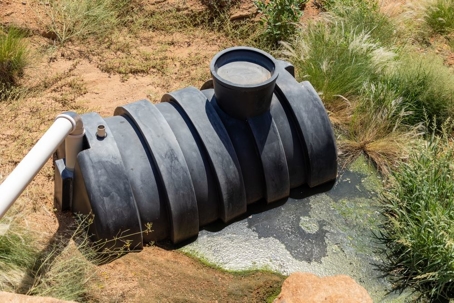Diamonds are forever, but septic systems are not. It’s true that with proper care and maintenance, a wastewater system will last many years.
However, any septic tank buried in the ground will eventually deteriorate. Several factors determine how quickly a tank will deteriorate, including the construction material, environmental conditions, and the level of care it receives.
How Long Do Septic Tanks Last?
Life Expectancy of Plastic Septic Tanks
Plastic septic tanks should last 30+ years (with proper maintenance and care).
Life Expectancy of Concrete Septic Tanks
A concrete septic tank will last 40 years or more, provided the wastewater is not acidic.
Concrete septic tanks are sturdy and reliable, but not indestructible. The biggest risk is exposing the concrete to acidic substances.
Bacteria breaking down solid waste produce hydrogen sulfide gas. When hydrogen sulfide mixes with water vapors, such as the ones you’d find in a wastewater tank, it turns into sulfuric acid and eats away at the concrete.
Keeping vents open and clear of debris will decrease the risk of sulfuric acid formation.
Life Expectancy of Steel Septic Tanks
The life expectancy of a steel septic tank is generally shorter than that of a concrete septic tank. Inspectapedia estimates that steel tank baffles will rust out in 15 to 20 years and may collapse if driven over.
How Long Does a Leach Field Last?
It’s important to consider the life expectancy of your leach field (aka drain field), too. Under normal conditions and good leach field care and maintenance, a leach field will last for 50 years or more.
What Are the Signs My Septic System is Aging?
Signs of an aging septic system and the need for maintenance are as follows:
- A high, thick sludge layer. A thick layer of sludge leaves less room to filter wastewater before draining. A healthy system’s top layer will be dark brown and full of worms. Maintaining a low sludge level by regularly draining will prevent overflow.
- High levels of solid waste. Solid waste levels should not exceed one-third of the tank's depth. To remedy this, have the tank serviced more frequently to prevent the growth of bacteria that produce excess hydrogen sulfide.
- Visible wear and tear. Crumbly concrete and rust-colored streaks are signs of a structural problem that needs to be addressed immediately.
Septic systems require regular maintenance due to the effects of aging. Contact Wind River Environmental today to schedule a septic tank check-up!





